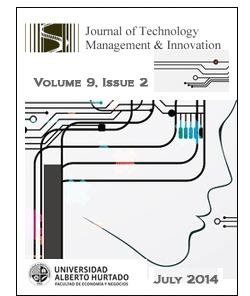What Types of Start-ups Receive Funding from the Small Business Innovation Research (SBIR) Program? Evidence from the Kauffman Firm Survey
DOI:
https://doi.org/10.4067/S0718-27242014000200002Keywords:
small and medium enterprises, research and development (R&D), high-technology start-ups, Small Business Innovation Research (SBIR), innovation policy, Kauffman Firm Survey (KFS)Abstract
This paper integrates the Kauffman Firm Survey with the Small Business Innovation Research (SBIR) recipient dataset to examine in more depth the characteristics of small business start-ups that received R&D subsidy from SBIR. Our selection analysis first shows that SBIR program funds are distributed disproportionately to start-ups whose owner has a post-graduate education. The odds of being granted SBIR R&D subsidies are also higher for those who had prior R&D experience and owned patents at the start of their business operations. Start-ups that are operating in the high-technology sector are also more likely to receive SBIR funds than start-ups in traditional sectors. Surprisingly, start-ups that did not sell goods and services are more likely to receive SBIR grants. Interestingly, location matters but at a different direction: start-ups located in states that are not known for their R&D performance are more likely to receive SBIR funding.Downloads
References
ACS, Z. J., & AUDRETSCH, D. B. (1990). Innovation and small firms. Cambridge, MA: MIT Press.
ALMEIDA, P., & KOGUT, B. (1997). The exploration of technological diversity and geographic localization in innovation: Start-Up firms in the semiconductor industry. Small Business Economics, 9(1), 21-31. doi: 10.1023/a:1007995512597
AUDRETSCH, D. B. (2003). Standing on the shoulders of midgets: The US Small Business Innovation Research program (SBIR). Small Business Economics, 20(2), 129-135. doi: 10.1023/A:1022259931084
AUDRETSCH, D. B., LINK, A. N., & SCOTT, J. T. (2002). Public/private technology partnerships: Evaluating SBIR-supported research. Research Policy, 31(1), 145-158. doi: 10.1016/S0048-7333(00)00158-X
AUDRETSCH, D. B., WEIGAND, J., & WEIGAND, C. (2002). The impact of the SBIR on creating entrepreneurial behavior. Economic Development Quarterly, 16(1), 32-38. doi: 10.1177/089124240201600104
BHIDE, A. (2008). The venturesome economy: how innovation sustains prosperity in a more connected world. Princeton, NJ: Princeton University Press.
BLACK, G. (2004). The geography of small firm innovation. Boston, MA: Kluwer Academic Publishers.
BREITZMAN, A., & HICKS, D. (2008). An analysis of small business patents by industry and firm size. [Contract Report to the Small Business Administration].
BRUDERL, J., PREISENDORFER, P., & ZIEGLER, R. (1992). Survival chances of newly founded business organizations. American Sociological Review, 57(2), 227-242.
COHEN, W. M., & LEVINTHAL, D. A. (1990). Absorptive capacity: A new perspective on learning and innovation. Administrative Science Quarterly, 35(1), 128-152. doi: 10.2307/2393553
COOPER, R. S. (2003). Purpose and performance of the Small Business Innovation Research (SBIR) program. Small Business Economics, 20(2), 137-151. doi: 10.1023/A:1022212015154
FELDMAN, M. P. (1994). The geography of innovation. Boston, MA: Kluwer Academic Publishers.
HEINZE, T., SHAPIRA, P., SENKER, J., & KUHLMANN, S. (2007). Identifying creative research accomplishments: Methodology and results for nanotechnology and human genetics. Scientometrics, 70(1), 125-152. doi: 10.1007/s11192-007-0108-6
HILL, C. T. (2007). The post-scientific society. Issues in Science and Technology, 24(1), 78-84.
HIPPEL, E. V. (2006). Democratizing innovation. Cambridge, MA: MIT Press.
JAFFE, A. B. (1986). Technological opportunity and spillovers of R&D: Evidence from firms' patents, profits, and market value. American Economic Review, 76(5), 984-1001.
JAFFE, A. B., TRAJTENBERG, M., & HENDERSON, R. (2002). Geographic localization of knowledge spillovers as evidenced by patent citation. In A. B. Jaffe & M. Trajtenberg (Eds.), Patents, Citations, and Innovations: A Window on the Knowledge Economy (pp. 155-178). Cambridge, MA: The MIT Press.
JEWKES, J., SAWERS, D., & STILLERMAN, R. (1958). The sources of invention. London, UK: Macmillan.
LERNER, J. (1999). The government as venture capitalist: The long-run impact of the SBIR program. Journal of Business, 72(3), 285-318.
LINK, A. N., & SCOTT, J. T. (2000). Estimates of the social returns to Small Business Innovation Research projects. In C. W. Wessner (Ed.), The Small Business Innovation Research Program. (pp. 275–290.). Washington, D.C. : National Academy Press.
LUNDVALL, B.-A. (Ed.). (1992). National systems of innovation: Towards a theory of innovation and interactive learning. London, UK: Pinter Publishers.
PORTER, M. E. (1980). Competitive strategies. New York: The Free Press.
SHANE, S. (2000). Prior knowledge and the discovery of entrepreneurial opportunities. Organization Science, 11(4), 448-469. doi: 10.1287/orsc.11.4.448.14602
SHANE, S. (2008). The illusions of entrepreneurship: The costly myths that entrepreneurs, investors, and policy makers live by. New Haven, CT: Yale University Press.
TEECE, D. J. (1986). Profiting from technological innovation: Implications for integration, collaboration, licensing and public policy. Research Policy, 15(6), 285-305. doi: 10.1016/0048-7333(86)90027-2
WALLSTEN, S. J. (2000). The effects of government-industry R&D programs on private R&D: The case of the Small Business Innovation Research program. RAND Journal of Economics, 31(1), 82-100.
WETZEL, W. E. (1982). Risk capital research. In C. A. Kent, D. L. Sexton & K. H. Vesper (Eds.), Encyclopedia of entrepreneurship (pp. 140-164). Englewood Cliffs, NJ: Prentice Hall.
Downloads
Published
How to Cite
Issue
Section
License
Copyright (c) 2014 Journal of Technology Management & Innovation

This work is licensed under a Creative Commons Attribution-ShareAlike 4.0 International License.







